#dave katz fan art
Photo

Dave has auditory processing disorder and the women in his family have a sense of humor.
Kvell (verb): to gush with pride, usually about the accomplishments of your children, in order to impress your friends and make them feel like their children aren’t as good as yours.
Bubbie (noun): Yiddish for “grandma”
[Image ID: a five-panel digital comic showing Dave and Klaus in a bar on Christmas in 1968. Dave and Klaus are at the bar top with a beer each. Dave is on the left and there is green light shining across him, and Klaus is on the right with red light shining across him. Dave is wearing a blue sweater. Klaus is wearing a Santa hat, black shirt with a high neck, and an ivory coat.
First panel: Dave and Klaus have their arms around each other, and they are singing “It’s the most wonderful time of the year!”
Second panel: Dave continues the song, singing, “With bells jingle-belling and everyone kvelling that we gotta hear!”
Third panel: Klaus pauses to ask, “I’m sorry, what did you just say?”
Fourth panel: Klaus realizes what Dave sang, and says “Dave, the word ‘kvelling’ isn’t in a Christmas song.” His right hand is pounding on the table and he’s laughing. Dave is a little embarrased.
Fifth panel: Dave says “Well that’s how my bubbie and mom always sang it...” He also says “and it was written by two Jews so how was I supposed to know” in smaller text. Klaus is clutching the bar top with both hands and laughing hysterically. /end ID]
#I spent all day yesterday on and off making this. reblog it.#also yes that song was written by 2 Jews I looked it up#tua#the umbrella academy#klave#klaus hargreeves#dave katz#tua fanart#tua fan art#umbrella academy fanart#umbrella academy fan art#klave fanart#klave fan art#klaus hargreeves fan art#klaus hargreeves fanart#tua fandom#dave katz fanart#dave katz fan art
26 notes
·
View notes
Text

Oh, baby, I am a wreck when I'm without you
I need you here to stay
I’m back on my song lyric bullshit :)
(commissions open)
#tua#The Umbrella Academy#klaus hargreeves#dave katz#klave#klaus hargreeves x dave katz#klaus hargreeves/dave katz#klaus#dave#my art#fanart#blood cw#cw blood#lyric#line without a hook#comic#fan comic#art
145 notes
·
View notes
Text
Happy pride bitches!!!!!!!
Love you all. Since I don't have anything else to share here a colorful fanart I made for pride a few months ago

59 notes
·
View notes
Note
I saw the fic drawing post and maybe you could draw something from Who You Gonna Call by lesbuchanan !!

ask and ye shall receive! Who You Gonna Call? by @lesbuchanan
3/? of Fic Illustrations - if you’ve got a fic you’d like to see illustrated, shoot me an ask!
#thanks for the suggestion!#Anonymous#art#fic recs#fan art#tua#The Umbrella Academy#fic illustration#kaydrawsfic#diego hargreeves#klaus hargreeves#dave katz
55 notes
·
View notes
Text
The Misadventures of Nero Wolfe edited by Josh Pachter
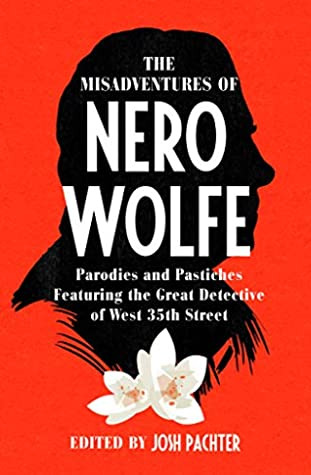
Subtitled: Parodies and Pastiches Featuring the Great Detective of West 35th Street
I loved this collection of stories, with only a few exceptions. Overall, I would give it 4.5 out of 5.
Introductions: Trouble in Triplicate
“At Wolfe’s Door” by Otto Penzler ~ about the characters.
“A Family Affair” by Rebecca Stout Bradbury ~ Rex Stout’s daughter provides a peek at the author.
“Plot It Yourself” by Josh Pachter ~ how the collection came to be.
Pastiches (Respectful imitations of the original works)
“The Red Orchid” by Thomas Narcejac
Translated from French, the story was written in 1947. The first English publication wasn’t until 1961. A young woman comes to hire Wolfe to discover who is trying to kill her uncle, a man who claims to have developed a red orchid. More creepy than respectful, especially how Archie hits on the female client. Too offensive for me. DNF
“Chapter 8 from ‘Murder in Pastiche’” by Marion Mainwaining
Published in 1955, this novel can also be found under the title of “Nine Detectives All at Sea”. A notorious gossip columnist is murdered during a sea cruise across the Atlantic. There are nine famous detectives on the ship as passengers. Trajan Beare, aka Nero Wolfe, is the focus of this particular chapter. It is hard to judge the whole book based on just one chapter. However, the characterization should be noted as being extremely close to the original source material. A nice read. No rating as it is just an excerpt.
“The Archie Hunters” by Jon L. Breen
Written in 1968, but never published until now. A cross of Nero Wolfe and Mike Hammer. Mock Himmler beats the crap out of anyone he encounters, particularly if they disagree with him or do something he doesn’t like. After beating up a news seller for carrying a “commie” magazine, Mock discovers an ad in the back requesting a private investigator for a missing person case. The ad, placed by Nero Wolfe, leads Mock to presume the missing person is Archie Goodwin. I’ve never been a fan of Mike Hammer nor his creator, Mickey Spillane, finding both of them to be disgusting in their love of violence, misogyny, and attitudes in general. I did enjoy this story nonetheless. 4 out of 5
“The Frightened Man” by O. X. Rusett
Gave up early on this anagram-stuffed story, even to the author’s name. More annoying than clever or cute. DNF
“Chapter 1 from ‘Murder in E Minor’” by Robert Goldsborough
I read the whole book when it was first published and, frankly, wasn’t too impressed. I do know that Goldsborough was selected by the Stout Estate to be the official author of the novels and I have read a few of his more recent books. I may try and reread it sometime down the road to see if my opinion has changed. No rating as it is only one chapter.
“The Purloined Platypus” by Marvin Kaye
While Goldsborough has the exclusive novel rights, Kaye asked to write short stories and was given the Estate’s permission as long as no novels were ever written. Benjamin Moultrie, president and board chairman of the Museum of the Strange, Odd and Peculiar, wants to hire Wolfe to investigate a robbery at the museum. As I wasn’t reading the magazines such as Ellery Queen and Alfred Hitchcock, I missed reading any of these stories. Which is quite a tragedy. Excellent portrayals of not only the characters, but the case itself. 4 out of 5.
Parodies (Exaggerated imitations intended to poke fun at the source material)
“The House on 35th Street” by Frank Littler
Originally appeared in The Saturday Review in 1966. Little is known about the author, despite Pachter’s research attempts. A crowd is assembled in the Brownstone in a murder case, wanting to see some of the detective’s famous actions and quirks. There is an undercurrent of a very personal nature, especially at the end. 3.5 out of 5
“The Sidekick Case” by Patrick Butler
Another entry from The Saturday Review, this time in 1968, and another case of little information on the author. Wolfe objects to Archie being called a “sidekick” in a listing of the latest book. Cute. 3.5 out of 5
“The Case of the Disposable Jalopy” by Mack Reynolds
America has turned into an illiterate welfare state, Wolfe and Archie are old and sometimes forgetful, and things are beyond tight financially. Reynolds uses the last names of some of the biggest authors in Science Fiction in the story. These men want to hire Wolfe for a case of sabotage and the disappearance of a key developer. What a weird world Reynolds has built. As to the updates on the normal cast of characters in the series? Well, I never liked Orrie anyway. 4 out of 5
“As Dark as Christmas Gets” by Lawrence Block
An unpublished manuscript written by Cornell Woolrich is stolen during a Christmas party. The owner hires Wolfe wannabe Leo Haig and his Goodwin substitute, Chip Harrison, to recover it. I’ve come across stories in this series before and loved them, both for the obvious affection for the source material as well as the excellent characterization. 4.5 out of 5
“Who’s Afraid of Nero Wolfe?” by Loren D. Estleman
Arnie Woodbine, currently on parole, was fired from his last job for gambling on company time. He needs a job and finds an ad looking for an assistant sharp of wit. He finds himself hired by Claudius Lyon, a corpulent man with delusions of being Nero Wolfe. Arnie is hired as his Archie. Now all they need is a case. Since Lyon doesn’t have a private detective license and Arnie’s felony record prevents him from ever getting one, they would not be able to charge for their services. No problem as Lyon is actually quite wealthy. Their first case is regarding a poetry award that carries with it a $10,000 prize. One winner doesn’t appear to actually exist. Seriously one of the best sendups that I’ve ever read! This was a delight to read and deserved more stories. 4.5 out of 5.
“Julius Katz and the Case of Exploding Wine” by Dave Zeltserman
A friend of Julius’ that has a champion bulldog and heads a dog food company comes to see Julius with the dog in tow, asking for help to find someone to prevent Brutus from being kidnapped. He also asks that Julius find his murderer if he’s killed. Sure enough, the man is killed. Julius had agreed to investigate, but only after he gave the police a week to solve it themselves. Just as the week is up, an adversary calls to warn Julius that there is a bomb in his house, contained in a box of wine. Julius allows almost everyone to believe he is dead after the townhouse is completely destroyed from top to bottom. I absolutely loved this sorta tribute to Rex Stout. I’m particularly intrigued by Archie, an AI who is installed in Julius’ tie pin. That alone has me eyeing the book collections, but to be honest, this is a damn fine mystery. Julius is definitely not Nero Wolfe, at least in size, athleticism (martial arts), and loving women (a former womanizer who now has a regular girlfriend). He definitely is in the aspects of intelligence, laziness, and cutting Archie out of the loop. His collecting focus is wine rather than orchids, but both can be very expensive hobbies. 4.5 out of 5.
“The Possibly Last Case of Tiberius Dingo” by Michael Bracken
Age and diet are catching up to Tiberius Dingo’s body, but his mind and deductive reasoning is still as sharp as ever. His long-time assistant, Jughead Badloss, brings a client he dances with at the Senior Center, a woman who is certain she is being stalked. Family ties and age-old secrets are ripped out into the open before the case is done, for their client and for Jughead himself. The names are a little lame, but the story made up for it. 3.5 out of 5.
Potpourri
“The Woman Who Read Rex Stout” by William Brittain
Gertrude Jellison was the fat lady at a carnival sideshow, an intelligent woman whose extreme weight, over 500 pounds, kept her from her dream job of teaching psychology. Her partner, Robert Kirby, is the thin man, barely weighing seventy-five pounds. As a stunt, the carnival boss gave her Rex Stout’s Nero Wolfe books to read during the shows. Surprisingly enough, Gert loved them and continued reading. She never expected to use what she learned to solve a murder, but sadly a newer member of the troup, a beautiful woman named Lili who was like a daughter to Gert, is murdered and the older woman knows she can solve the crime. This is a character that I could seriously have loved to read more about. A good little mystery as well, even if I quickly realized who the murderer would turn out to be. 3.5 out of 5.
“Sam Buried Caesar” by Josh Pachter
Police inspector Griffen had eleven children, each of whom was named after a famous fictional detective. Nero, just eleven years old, had set up his own detective agency, aided by his best friend and neighbor Artie Goodman. Their latest client, Sam, came to them after his dog, Caesar, was hit and killed by an out-of-state driver. Not wanting the poor animal to be left coldly abandoned on the street, he buried the dog in an empty lot. Coming back a short time later to get Caesar’s collar, the body is missing. He hires Nero and Artie to find the killer and recover the body. Sad and cute and inventive, but how Artie puts up with Nero will always be a mystery. 3.5 out of 5.
“Chapter 24 from Rasputin’s Revenge” by John Lescroart
The basic premise is that Nero Wolfe is the son of Sherlock Holmes and Irene Adler. I’ve not read this particular book, but it appears to be the last chapter in which Archie and Wolfe, going under his original name, are in Russia, appeared to have come up against Gregori Rasputin (although the author has it as Gregory), and was helped by Holmes and Dr. Watson after they were wanted for murder. I’m not going to rate it as I don’t consider it fair to rate a novel based on just one chapter.
“A scene from Might as Well Be Dead” by Joseph Goodrich
Adaptation of the story into a play. Once again, not rated.
“The Damned Doorbell Rang” by Robert Lopresti
When their fourteen granddaughter came to visit in a snit because her parents won’t allow her to go with friends to a concert in New York City, Eve and Jack decide to tell her about why they left the City. When they were younger, they had a brownstone in the City. Their neighbors were definitely different, all men living there. Jack didn’t much like any of them and keeps disparaging Eve’s stories about what they saw while living there. But Eve tells a tale of how she saved the men’s lives. Too many close calls are the reason that they moved to New Jersey. How could I not love this outsider’s look at Nero Wolfe? 3.5 out of 5.
#book review#Nero Wolfe#collection#The Misadventures of Nero Wolfe#Josh Pachter#mystery#short stories
5 notes
·
View notes
Text
From the Strategist: Everything You Need to Start Fermenting at Home

The best books, salts, and tools to kickstart a vegetable preserving hobby, from the Strategist
It’s very likely that your fridge has never been fuller than it is right now. Sure, you’re going to the grocery store less, but you’re buying more when you would on a typical shopping trip. Most produce — vegetables, in particular — has a tendency to go bad if you don’t use it quickly. One very easy way to extend the shelf life (and allow you to go even more time between grocery runs) is with fermentation.
Fermentation involves allowing the naturally occurring bacteria on fruits and vegetables to thrive and produce lactic acid, which helps preserve them. The most common examples of this are sauerkraut and kimchi, but as Michael Perrine, founder of rejuvenation and detox clinic Vitality NYC says, almost any vegetable will do as long as it’s hardy. “Cabbage, carrots, beets, and other roots ferment really well,” he says. “I suggest using them as a base even if adding other veggies.” Perrine is one of seven experts we asked — including chefs, cookbook authors, and a professional sauerkraut-maker — for advice on everything you need to become a modern preservation-minded homesteader. Here’s how to get started fermenting at home.
Salt
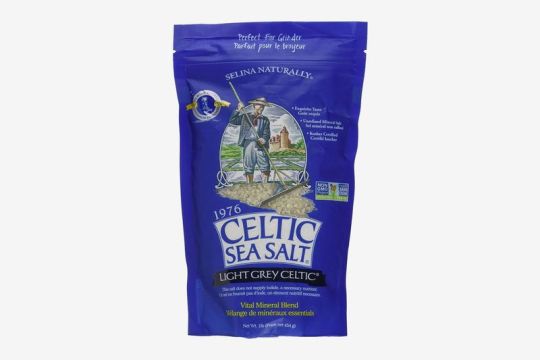
Photo: retailer
Light Grey Celtic Sea Salt
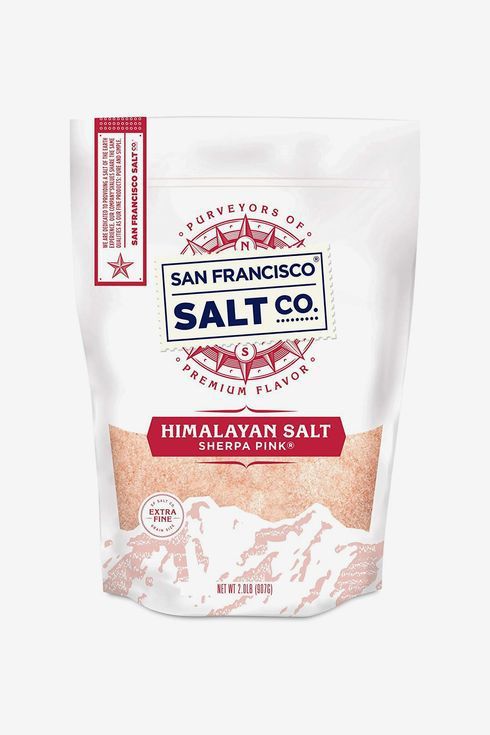
Sherpa Pink Gourmet Himalayan Salt

ILA Sonoma Sea Salt
The foundation of lactic fermentation is salt, which, according to Perrine, “creates an environment where lactic-acid bacteria will completely take over the medium destroying all the bacteria, molds, and yeasts.” There’s a bit of a divide on what salts to use, however: Kathryn Lukas, founder of Farmhouse Culture and co-author of The Farmhouse Culture Guide to Fermenting, prefers high-quality, plain sea salt. “I like a higher sodium fluoride salt, like Sonoma sea salt, because it’s really, really high in sodium chloride,” she says. “Some of these other salts, like Celtic sea salt or Himalayan sea salt, can be as low as 90% sodium chloride and the rest are minerals.”
Perrine is in the latter camp, saying that he likes to use Celtic sea salt and Himalayan for not only the mineral flavor they lend but the health benefits of adding those minerals to a ferment. “I find a ratio of two teaspoons of salt per pound of vegetable to be perfect,” he says. Either way, look for the most natural salt you can. “Make sure that there are no additives, no anti-caking agents, no bleach, or anything like that,” says Lukas. “That’ll screw up the fermentation quickly.”
Jars
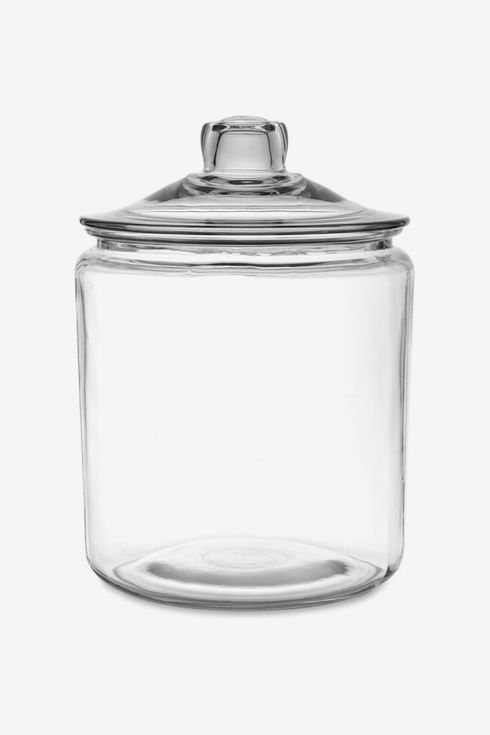
Large Biscotti Jar
Next comes the equipment, which costs little more than a jar of premade kimchi. If you’re not quite sure you want to fully commit, David Zilber, head of fermentation at Noma in Copenhagen, says feel free to purchase a biscotti jar, which you can store in a dark cabinet during the fermentation process. “They’re much simpler to find,” he says, plus “they’re durable, they’re machine-washable, and they look as gorgeous as a fancy ceramic crock.” And if you give up on fermenting, you’ll end up with a very nice looking jar.
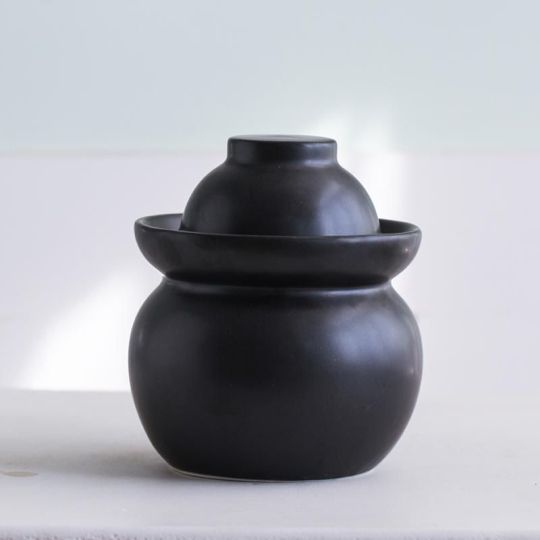
Mini Kimchi Jar
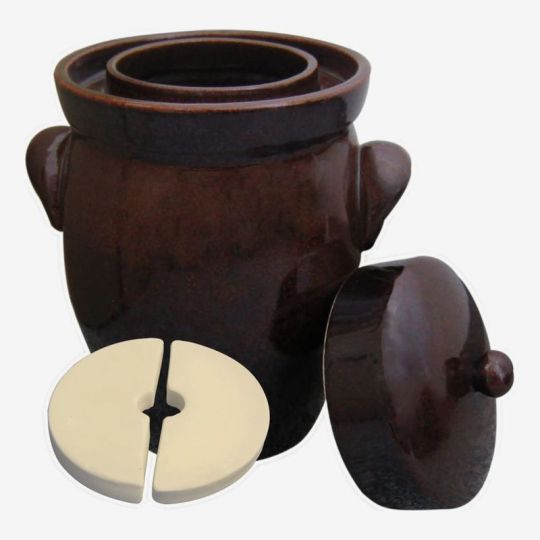
German Made Fermenting Crock Pot
If you want to keep your ferments on your kitchen counter, though, you’ll need a crock that keeps out the sunlight. Amelie Kang, the chef and owner of Sichuan dry-pot restaurant MáLà Project in New York City, is a fan of “jellyfish” pickle jars. “After pickling, you can close the jar by putting the cap bowl upside down and then pour water into the curve, creating the perfect seal.” she says.
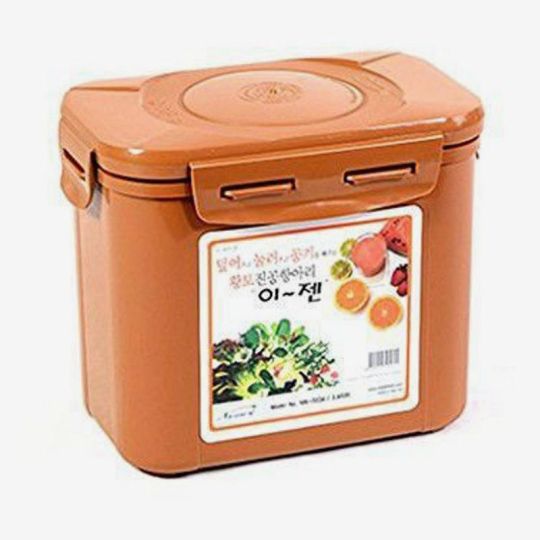
E-Jen Premium Kimchi, Sauerkraut Container Earthenware Brown 1.7L
Chefs Dave Park of Jeong in Chicago and Kevin Fink of Austin’s Emmer & Rye, meanwhile, are evangelists of the E-Jen Kimchi container. “It’s one of my favorite containers to ferment in,” Park says. “It’s really useful because it has an insert that essentially creates a vacuum to press down your ferments. It has an inner ring where you can either burp your ferments or keep it airtight. It’s definitely one of the most useful containers I’ve found.”
They’re also perfect for when you want to start fermenting dairy. “These crocks are great for producing cultured butter or yogurts and other items that have a higher probability of rancidity,” says Fink. “The lack of light penetration makes checking them more necessary, but the end product is more stable.”
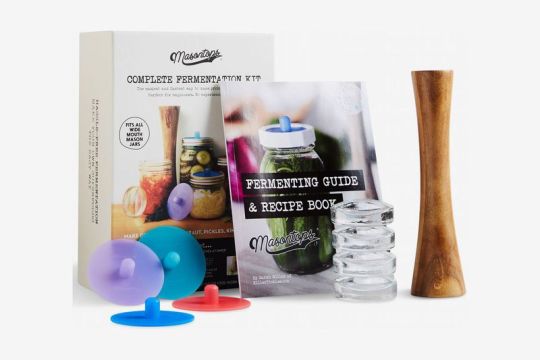
Complete Mason Jar Fermentation Kit
Or you can just click one link and be done. “I like to refer people to culturesforhealth.com to order one of their kits,” says Perrine of Vitality NYC. “They also have gallons and lids for 16-ounce ball jars because I always say you may as well go big so you can do it less often. Cultures for Health makes it easy enough though to get everything at once.”
Handbooks
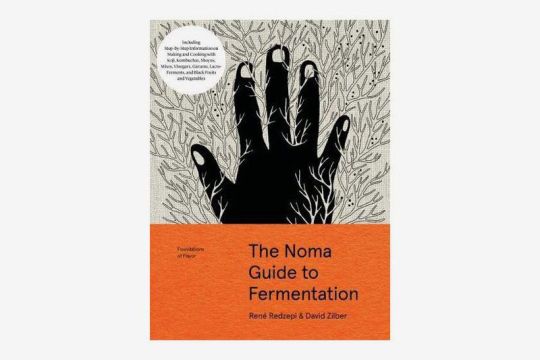
Photo: retailer
The Noma Guide to Fermentation
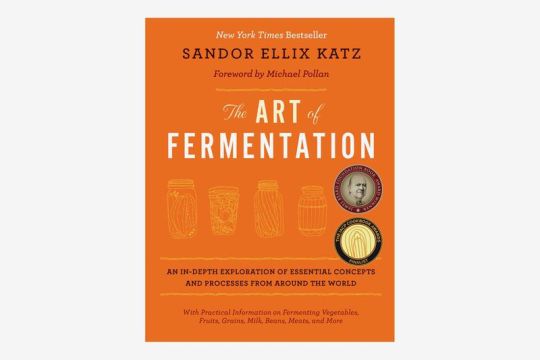
Photo: retailer
The Art of Fermentation
Fermenting can be as simple as salt, cabbage, and a jar you can burp or as complicated as a multi-ingredient kimchi. If you’re not quite sure where to begin, though, there’s plenty of literature out there to get you inspired. Park of Jeong turns to two books.
“I really like these books because of the detailed information they provide,” Park says. “The Art of Fermentation contains a lot of general knowledge of all the different fermented products of the world in a very relaxed manner and helps you understand how you might be able to start making all of your fermented projects. The Noma Guide to Fermentation digs deeper into the science and details of some major ferments, such as shoyu, vinegars, and miso. It is more technical and precise, with things like temperature control, humidity levels, and bacteria.”
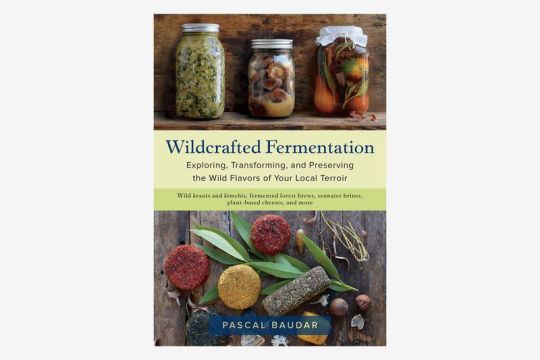
Photo: retailer
Wildcrafted Fermentation: Exploring, Transforming, and Preserving the Wild Flavors of Your Local Terroir
And if you really want to get outdoorsy, Sandor Ellix Katz, the aforementioned author of The Art of Fermentation, heartily endorses Wildcrafted Fermentation by wild-food researcher Pascal Baudar, which was published in March. “Pascal is a culinary visionary, experimenting with what he finds outside his home and in nearby forests and using it for its flavors and as fermentation starters,” Katz says. “He’s taking fundamental fermentation processes and applying them in innovative and exciting ways.”
Tools
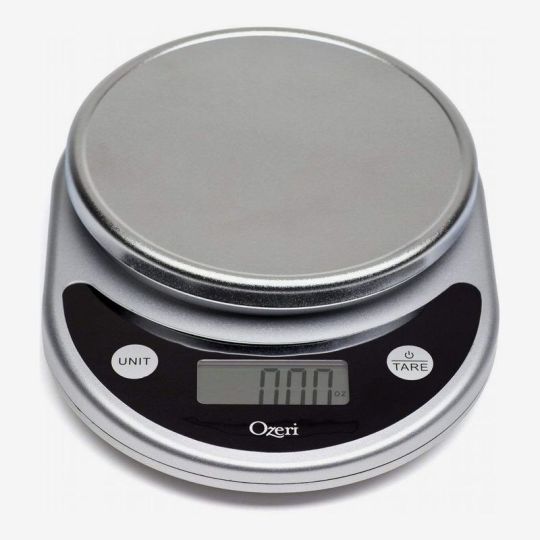
Ozeri ZK14-S Pronto Digital Multifunction Kitchen and Food Scale

Canning Funnel

Sur La Table Non-Skid Stainless Steel Mixing Bowls, Set of 3
Once you have all your fermenting equipment, it’s time to get started. Sauerkraut maker Kathryn Lukas says you need just three key tools: A small scale to weigh your vegetables, which determines how much salt you’ll use. (“You can get one for $20,” Lukas says.); a large stainless steel or ceramic bowl; and a canning funnel, which helps prevent overfilling your fermentation vessel. “And then a knife and a cutting board for cutting the vegetables into smaller pieces,” Lukas adds.
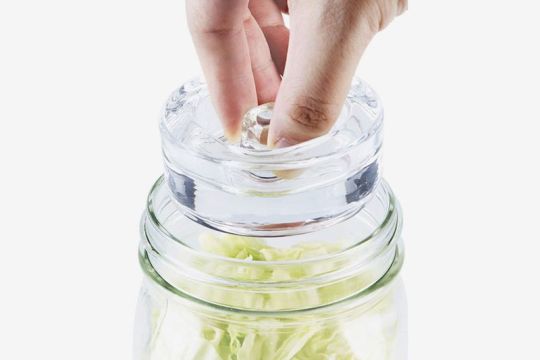
Photo: retailer
4-Pack of Fermentation Glass Weights with Easy Grip Handle for Wide Mouth Mason Jar
If you’re using a jar or other large container, you’ll need to make sure the fermenting produce is kept away from open air, which can carry yeast, mold, and other bacteria that you don’t want in your ferment. The solution: Glass or ceramic weights. “Their purpose is to keep all the food you’re trying to ferment beneath the water line,” Zilber of Noma told the Strategist back in 2018. “If they’re not packed down nicely in the jar, there’ll be lots of air. A good weight that’s heavy enough and fits the jar nicely without getting stuck on the sides is very important.”

6 Pack 0.94 Inch Blue Painters Tape
And then it’s just a matter of waiting. “I find most ferments to be finished in 10 to 14 days,” says Perrine. “The temperature is the determining factor. If it’s very warm, fermentation will happen faster, while cold temperatures slow it down.” Just keep in mind that the longer you let the ferment go, the funkier it will get. “The real fermentation connoisseurs say the best flavor is achieved at cooler temperatures for long periods, as long as 20 to 30 days,” he continues. “This allows different types of bacteria to take over, creating a more pleasing flavor. All that’s to say, label and date your ferments. I always forget when I made it and have to check my Instagram Story archive to figure it out.”
from Eater - All https://ift.tt/2LPqRNH
https://ift.tt/3cS8NhN

The best books, salts, and tools to kickstart a vegetable preserving hobby, from the Strategist
It’s very likely that your fridge has never been fuller than it is right now. Sure, you’re going to the grocery store less, but you’re buying more when you would on a typical shopping trip. Most produce — vegetables, in particular — has a tendency to go bad if you don’t use it quickly. One very easy way to extend the shelf life (and allow you to go even more time between grocery runs) is with fermentation.
Fermentation involves allowing the naturally occurring bacteria on fruits and vegetables to thrive and produce lactic acid, which helps preserve them. The most common examples of this are sauerkraut and kimchi, but as Michael Perrine, founder of rejuvenation and detox clinic Vitality NYC says, almost any vegetable will do as long as it’s hardy. “Cabbage, carrots, beets, and other roots ferment really well,” he says. “I suggest using them as a base even if adding other veggies.” Perrine is one of seven experts we asked — including chefs, cookbook authors, and a professional sauerkraut-maker — for advice on everything you need to become a modern preservation-minded homesteader. Here’s how to get started fermenting at home.
Salt

Photo: retailer
Light Grey Celtic Sea Salt

Sherpa Pink Gourmet Himalayan Salt

ILA Sonoma Sea Salt
The foundation of lactic fermentation is salt, which, according to Perrine, “creates an environment where lactic-acid bacteria will completely take over the medium destroying all the bacteria, molds, and yeasts.” There’s a bit of a divide on what salts to use, however: Kathryn Lukas, founder of Farmhouse Culture and co-author of The Farmhouse Culture Guide to Fermenting, prefers high-quality, plain sea salt. “I like a higher sodium fluoride salt, like Sonoma sea salt, because it’s really, really high in sodium chloride,” she says. “Some of these other salts, like Celtic sea salt or Himalayan sea salt, can be as low as 90% sodium chloride and the rest are minerals.”
Perrine is in the latter camp, saying that he likes to use Celtic sea salt and Himalayan for not only the mineral flavor they lend but the health benefits of adding those minerals to a ferment. “I find a ratio of two teaspoons of salt per pound of vegetable to be perfect,” he says. Either way, look for the most natural salt you can. “Make sure that there are no additives, no anti-caking agents, no bleach, or anything like that,” says Lukas. “That’ll screw up the fermentation quickly.”
Jars

Large Biscotti Jar
Next comes the equipment, which costs little more than a jar of premade kimchi. If you’re not quite sure you want to fully commit, David Zilber, head of fermentation at Noma in Copenhagen, says feel free to purchase a biscotti jar, which you can store in a dark cabinet during the fermentation process. “They’re much simpler to find,” he says, plus “they’re durable, they’re machine-washable, and they look as gorgeous as a fancy ceramic crock.” And if you give up on fermenting, you’ll end up with a very nice looking jar.

Mini Kimchi Jar

German Made Fermenting Crock Pot
If you want to keep your ferments on your kitchen counter, though, you’ll need a crock that keeps out the sunlight. Amelie Kang, the chef and owner of Sichuan dry-pot restaurant MáLà Project in New York City, is a fan of “jellyfish” pickle jars. “After pickling, you can close the jar by putting the cap bowl upside down and then pour water into the curve, creating the perfect seal.” she says.

E-Jen Premium Kimchi, Sauerkraut Container Earthenware Brown 1.7L
Chefs Dave Park of Jeong in Chicago and Kevin Fink of Austin’s Emmer & Rye, meanwhile, are evangelists of the E-Jen Kimchi container. “It’s one of my favorite containers to ferment in,” Park says. “It’s really useful because it has an insert that essentially creates a vacuum to press down your ferments. It has an inner ring where you can either burp your ferments or keep it airtight. It’s definitely one of the most useful containers I’ve found.”
They’re also perfect for when you want to start fermenting dairy. “These crocks are great for producing cultured butter or yogurts and other items that have a higher probability of rancidity,” says Fink. “The lack of light penetration makes checking them more necessary, but the end product is more stable.”

Complete Mason Jar Fermentation Kit
Or you can just click one link and be done. “I like to refer people to culturesforhealth.com to order one of their kits,” says Perrine of Vitality NYC. “They also have gallons and lids for 16-ounce ball jars because I always say you may as well go big so you can do it less often. Cultures for Health makes it easy enough though to get everything at once.”
Handbooks

Photo: retailer
The Noma Guide to Fermentation

Photo: retailer
The Art of Fermentation
Fermenting can be as simple as salt, cabbage, and a jar you can burp or as complicated as a multi-ingredient kimchi. If you’re not quite sure where to begin, though, there’s plenty of literature out there to get you inspired. Park of Jeong turns to two books.
“I really like these books because of the detailed information they provide,” Park says. “The Art of Fermentation contains a lot of general knowledge of all the different fermented products of the world in a very relaxed manner and helps you understand how you might be able to start making all of your fermented projects. The Noma Guide to Fermentation digs deeper into the science and details of some major ferments, such as shoyu, vinegars, and miso. It is more technical and precise, with things like temperature control, humidity levels, and bacteria.”

Photo: retailer
Wildcrafted Fermentation: Exploring, Transforming, and Preserving the Wild Flavors of Your Local Terroir
And if you really want to get outdoorsy, Sandor Ellix Katz, the aforementioned author of The Art of Fermentation, heartily endorses Wildcrafted Fermentation by wild-food researcher Pascal Baudar, which was published in March. “Pascal is a culinary visionary, experimenting with what he finds outside his home and in nearby forests and using it for its flavors and as fermentation starters,” Katz says. “He’s taking fundamental fermentation processes and applying them in innovative and exciting ways.”
Tools

Ozeri ZK14-S Pronto Digital Multifunction Kitchen and Food Scale

Canning Funnel

Sur La Table Non-Skid Stainless Steel Mixing Bowls, Set of 3
Once you have all your fermenting equipment, it’s time to get started. Sauerkraut maker Kathryn Lukas says you need just three key tools: A small scale to weigh your vegetables, which determines how much salt you’ll use. (“You can get one for $20,” Lukas says.); a large stainless steel or ceramic bowl; and a canning funnel, which helps prevent overfilling your fermentation vessel. “And then a knife and a cutting board for cutting the vegetables into smaller pieces,” Lukas adds.

Photo: retailer
4-Pack of Fermentation Glass Weights with Easy Grip Handle for Wide Mouth Mason Jar
If you’re using a jar or other large container, you’ll need to make sure the fermenting produce is kept away from open air, which can carry yeast, mold, and other bacteria that you don’t want in your ferment. The solution: Glass or ceramic weights. “Their purpose is to keep all the food you’re trying to ferment beneath the water line,” Zilber of Noma told the Strategist back in 2018. “If they’re not packed down nicely in the jar, there’ll be lots of air. A good weight that’s heavy enough and fits the jar nicely without getting stuck on the sides is very important.”

6 Pack 0.94 Inch Blue Painters Tape
And then it’s just a matter of waiting. “I find most ferments to be finished in 10 to 14 days,” says Perrine. “The temperature is the determining factor. If it’s very warm, fermentation will happen faster, while cold temperatures slow it down.” Just keep in mind that the longer you let the ferment go, the funkier it will get. “The real fermentation connoisseurs say the best flavor is achieved at cooler temperatures for long periods, as long as 20 to 30 days,” he continues. “This allows different types of bacteria to take over, creating a more pleasing flavor. All that’s to say, label and date your ferments. I always forget when I made it and have to check my Instagram Story archive to figure it out.”
from Eater - All https://ift.tt/2LPqRNH
via Blogger https://ift.tt/3cSYry3
0 notes
Photo

Bittersweet Changes: This is just my Bittersweet Candy Bowl crossover fan art drawing of Paulo being changed into an aardvark being Profion/Jeremy Irons from the Dungeons and Dragons movie while Profion is changing Cerebus into a cat, I drew this to be a cute joke and I just wanted to see how Paulo would look if I drew him into a Dave Sim stylized Aardvark and to see how Cerebus would look if I drew him into a Swat Katz stylized cat, I haven't drawn Bittersweet Candy Bowl fan art in awhile since I drew Paulo and Josh in a Swat Katz style for fun, but I still read and follow the furry webcomic, Bittersweet Candy Bowl, and I had fun drawing the exaggerated expression on Paulo's uni-eyes with a mix of Cerebus and ed edd n Eddy exaggerated eye expressions, and I hope you bittersweet candy bowl fans,Cerebus fans, and Jeremy irons fans out there like it?
#bittersweet candy bowl#cerebus#jeremy irons#fan art#digital drawing#cartoonist#illustrator#colorist#Blake Andrew Roten
4 notes
·
View notes
Text
From the Strategist Everything You Need to Start Fermenting at Home added to Google Docs
From the Strategist Everything You Need to Start Fermenting at Home
The best books, salts, and tools to kickstart a vegetable preserving hobby, from the Strategist
It’s very likely that your fridge has never been fuller than it is right now. Sure, you’re going to the grocery store less, but you’re buying more when you would on a typical shopping trip. Most produce — vegetables, in particular — has a tendency to go bad if you don’t use it quickly. One very easy way to extend the shelf life (and allow you to go even more time between grocery runs) is with fermentation.
Fermentation involves allowing the naturally occurring bacteria on fruits and vegetables to thrive and produce lactic acid, which helps preserve them. The most common examples of this are sauerkraut and kimchi, but as Michael Perrine, founder of rejuvenation and detox clinic Vitality NYC says, almost any vegetable will do as long as it’s hardy. “Cabbage, carrots, beets, and other roots ferment really well,” he says. “I suggest using them as a base even if adding other veggies.” Perrine is one of seven experts we asked — including chefs, cookbook authors, and a professional sauerkraut-maker — for advice on everything you need to become a modern preservation-minded homesteader. Here’s how to get started fermenting at home.
Salt Photo: retailer Light Grey Celtic Sea Salt
Sherpa Pink Gourmet Himalayan Salt
ILA Sonoma Sea Salt
The foundation of lactic fermentation is salt, which, according to Perrine, “creates an environment where lactic-acid bacteria will completely take over the medium destroying all the bacteria, molds, and yeasts.” There’s a bit of a divide on what salts to use, however: Kathryn Lukas, founder of Farmhouse Culture and co-author of The Farmhouse Culture Guide to Fermenting, prefers high-quality, plain sea salt. “I like a higher sodium fluoride salt, like Sonoma sea salt, because it’s really, really high in sodium chloride,” she says. “Some of these other salts, like Celtic sea salt or Himalayan sea salt, can be as low as 90% sodium chloride and the rest are minerals.”
Perrine is in the latter camp, saying that he likes to use Celtic sea salt and Himalayan for not only the mineral flavor they lend but the health benefits of adding those minerals to a ferment. “I find a ratio of two teaspoons of salt per pound of vegetable to be perfect,” he says. Either way, look for the most natural salt you can. “Make sure that there are no additives, no anti-caking agents, no bleach, or anything like that,” says Lukas. “That’ll screw up the fermentation quickly.”
Jars Large Biscotti Jar
Next comes the equipment, which costs little more than a jar of premade kimchi. If you’re not quite sure you want to fully commit, David Zilber, head of fermentation at Noma in Copenhagen, says feel free to purchase a biscotti jar, which you can store in a dark cabinet during the fermentation process. “They’re much simpler to find,” he says, plus “they’re durable, they’re machine-washable, and they look as gorgeous as a fancy ceramic crock.” And if you give up on fermenting, you’ll end up with a very nice looking jar.
Mini Kimchi Jar
German Made Fermenting Crock Pot
If you want to keep your ferments on your kitchen counter, though, you’ll need a crock that keeps out the sunlight. Amelie Kang, the chef and owner of Sichuan dry-pot restaurant MáLà Project in New York City, is a fan of “jellyfish” pickle jars. “After pickling, you can close the jar by putting the cap bowl upside down and then pour water into the curve, creating the perfect seal.” she says.
E-Jen Premium Kimchi, Sauerkraut Container Earthenware Brown 1.7L
Chefs Dave Park of Jeong in Chicago and Kevin Fink of Austin’s Emmer & Rye, meanwhile, are evangelists of the E-Jen Kimchi container. “It’s one of my favorite containers to ferment in,” Park says. “It’s really useful because it has an insert that essentially creates a vacuum to press down your ferments. It has an inner ring where you can either burp your ferments or keep it airtight. It’s definitely one of the most useful containers I’ve found.”
They’re also perfect for when you want to start fermenting dairy. “These crocks are great for producing cultured butter or yogurts and other items that have a higher probability of rancidity,” says Fink. “The lack of light penetration makes checking them more necessary, but the end product is more stable.”
Complete Mason Jar Fermentation Kit
Or you can just click one link and be done. “I like to refer people to culturesforhealth.com to order one of their kits,” says Perrine of Vitality NYC. “They also have gallons and lids for 16-ounce ball jars because I always say you may as well go big so you can do it less often. Cultures for Health makes it easy enough though to get everything at once.”
Handbooks Photo: retailer The Noma Guide to Fermentation
Photo: retailer The Art of Fermentation
Fermenting can be as simple as salt, cabbage, and a jar you can burp or as complicated as a multi-ingredient kimchi. If you’re not quite sure where to begin, though, there’s plenty of literature out there to get you inspired. Park of Jeong turns to two books.
“I really like these books because of the detailed information they provide,” Park says. “The Art of Fermentation contains a lot of general knowledge of all the different fermented products of the world in a very relaxed manner and helps you understand how you might be able to start making all of your fermented projects. The Noma Guide to Fermentation digs deeper into the science and details of some major ferments, such as shoyu, vinegars, and miso. It is more technical and precise, with things like temperature control, humidity levels, and bacteria.”
Photo: retailer Wildcrafted Fermentation: Exploring, Transforming, and Preserving the Wild Flavors of Your Local Terroir
And if you really want to get outdoorsy, Sandor Ellix Katz, the aforementioned author of The Art of Fermentation, heartily endorses Wildcrafted Fermentation by wild-food researcher Pascal Baudar, which was published in March. “Pascal is a culinary visionary, experimenting with what he finds outside his home and in nearby forests and using it for its flavors and as fermentation starters,” Katz says. “He’s taking fundamental fermentation processes and applying them in innovative and exciting ways.”
Tools Ozeri ZK14-S Pronto Digital Multifunction Kitchen and Food Scale
Canning Funnel
Sur La Table Non-Skid Stainless Steel Mixing Bowls, Set of 3
Once you have all your fermenting equipment, it’s time to get started. Sauerkraut maker Kathryn Lukas says you need just three key tools: A small scale to weigh your vegetables, which determines how much salt you’ll use. (“You can get one for $20,” Lukas says.); a large stainless steel or ceramic bowl; and a canning funnel, which helps prevent overfilling your fermentation vessel. “And then a knife and a cutting board for cutting the vegetables into smaller pieces,” Lukas adds.
Photo: retailer 4-Pack of Fermentation Glass Weights with Easy Grip Handle for Wide Mouth Mason Jar
If you’re using a jar or other large container, you’ll need to make sure the fermenting produce is kept away from open air, which can carry yeast, mold, and other bacteria that you don’t want in your ferment. The solution: Glass or ceramic weights. “Their purpose is to keep all the food you’re trying to ferment beneath the water line,” Zilber of Noma told the Strategist back in 2018. “If they’re not packed down nicely in the jar, there’ll be lots of air. A good weight that’s heavy enough and fits the jar nicely without getting stuck on the sides is very important.”
6 Pack 0.94 Inch Blue Painters Tape
And then it’s just a matter of waiting. “I find most ferments to be finished in 10 to 14 days,” says Perrine. “The temperature is the determining factor. If it’s very warm, fermentation will happen faster, while cold temperatures slow it down.” Just keep in mind that the longer you let the ferment go, the funkier it will get. “The real fermentation connoisseurs say the best flavor is achieved at cooler temperatures for long periods, as long as 20 to 30 days,” he continues. “This allows different types of bacteria to take over, creating a more pleasing flavor. All that’s to say, label and date your ferments. I always forget when I made it and have to check my Instagram Story archive to figure it out.”
via Eater - All https://www.eater.com/21264126/how-to-ferment-vegetables-tips-products
Created May 21, 2020 at 10:26PM
/huong sen
View Google Doc Nhà hàng Hương Sen chuyên buffet hải sản cao cấp✅ Tổ chức tiệc cưới✅ Hội nghị, hội thảo✅ Tiệc lưu động✅ Sự kiện mang tầm cỡ quốc gia 52 Phố Miếu Đầm, Mễ Trì, Nam Từ Liêm, Hà Nội http://huongsen.vn/ 0904988999 http://huongsen.vn/to-chuc-tiec-hoi-nghi/ https://drive.google.com/drive/folders/1xa6sRugRZk4MDSyctcqusGYBv1lXYkrF
0 notes
Link
Bananaman The Musical – Matthew McKenna (Bananaman) Photo by Pamela Raith
Bananaman is flying to London to save the world! The most brainless superhero ever to grace the skies is going to make his live action debut in an all-singing, all-flying must-see new British musical.
Bananaman, the Man-of-Peel, is a unique member of the superhero ranks. Our handsome hero may have a jaw line you can see from space and sport the snazziest of tight lycra outfits, but this superhero has ‘the muscles of 20 men and the brain of 20 mussels.’ Which isn’t much.
With supervillains Doctor Gloom and General Blight attempting world domination who can we call? Superman’s on holiday, Spiderman’s not picking up – our only option, our very very last option is – Bananaman.
For the first time ever, Bananaman will be live on stage in Bananaman the Musical.
Bananaman the Musical, written and composed by Leon Parris, directed by Mark Perry, will run at Southwark Playhouse from December 15th 2017 to January 20th 2018. Press night is Thursday January 4, 2018 at 7.30pm
Bananaman began life in the Nutty comic in 1980, and was a flyaway success, transferring to The Dandy before joining the world’s longest-running comic, The Beano in 2012 and he is now one of The Beano’s flagship characters. A send-up of the likes of Superman and Batman, he was the subject of the hugely popular TV cartoon that ran between 1983 and 1986 for three series and 40 episodes on the BBC and featured the voices of Tim Brooke-Taylor, Graeme Garden and Bill Oddie from The Goodies.
Fans of the the TV series will remember the iconic opening sequence, “This is 29 Acacia Road. And this is Eric Wimp. He’s a schoolboy who leads an amazing double life. For when Eric eats a banana an amazing transformation occurs. Eric is Bananaman. Ever alert for the call to action.”
[See image gallery at http://ift.tt/1FpwFUw]
With a useless hero and some equally clueless villains, Bananaman’s winkingly clever, delightfully silly humour has been sealed into the memories of those who saw him first, and will now spark the imagination of a new bunch of Bananafans.
It won’t be long before we all ‘Peel the Power’ of Bananaman.
Matthew McKenna is unmasked today as the star and “handsome hero” of Bananaman the Musical. Matthew has appeared in many major West End musicals, including The Phantom of the Opera, Sunset Boulevard, Legally Blonde the Musical, We Will Rock You, Starlight Express (as Elektra), and The Rocky Horror Show (Riff Raff) and both Singing in the Rain and 42nd Street at the Theatre Du Chatelet, Paris.
Also starring, as Bananaman’s arch nemesis Doctor Gloom, the super villain seeking world domination, will be Marc Pickering. Marc Pickering returns to Southwark Playhouse where he appeared in the European premiere of Toxic Avenger The Musical. He recently starred as Finch in the musical How To Succeed in Business Without Really Trying (Wiltons Music Hall), Joseph Merrick in The Elephant Man (Trafalgar Studios), Merchant of Venice (Arcola) and The Glee Club (Hull Truck). His film work includes Sleepy Hollow, Calendar Girls, Kill Keith, I Want Candy, The Darkest Day and Montparnasse in Tom Hooper’s 2012 film of the celebrated musical Les Misérables. On TV he has appeared in the new series of Josh and Homeboys & Dalziel & Pascoe (BBC), played R Wayne in Peter Kay’s talent show parody Britain’s Got the Pop Factor, Ippolito D’este in Borgia III (for Netflix), and the young Enoch “Nucky” Thompson in the fifth and final season of the HBO series Boardwalk Empire.
Bringing the rest of the residents of Acacia Road to life are a stellar West End cast.
Jodie Jacobs (Broadway World Award Best Supporting Actress for Rock Of Ages) is Eric’s loyal sidekick, Crow. Jodie Jacobs has played Fantine in Les Misérables, Grizabella in Cats, Florence in Chess, Serena Katz in Fame and she understudied the lead roles of Scaramouche & Meatloaf in We Will Rock You (Dominion), Audrey in Little Shop of Horrors (Duke of York’s) and Eva Peron in Evita (Adelphi Theatre). Jodie has most recently been seen in The Lionel Bart Story as Judy Garland and Georgia Brown. She received an Off West End Award and a West End Wilma nomination for Lizzie (Greenwich Theatre and Denmark transfer), she won a Broadway World award for Best Supporting Actress for Rock Of Ages (West End). She was recently nominated Best Actress in a Musical as Atropos in the brand new musical 27 (Cockpit).
Mark Newnham (Eric Wimp) recently played Dave Davies in the Kinks musical Sunny Afternoon and the young Steve Marriott in the new musical All Or Nothing. His other roles include Cookie in Return to the Forbidden Planet, John Lennon in Lennon at Liverpool Royal Court Theatre, Jamie in The Last 5 Years, and Hot Stuff.
Carl Mullaney (General Blight) has appeared in Les Misérables, (West End), Chicago (West End & international tour as Mary Sunshine), Saucy Jack and the Space Vixens (Booby Shevalle), West Side Story, Jest End and Fashion Victim The Musical.
CHIEF O’REILLY – TJ Lloyd
T J Lloyd’s previous musicals include playing Nicely Nicely Johnson in Guys & Dolls, The Baker in Into The Woods, Charley Kringas in Merrily We Roll Along and Ray in Elegies for Angels, Punks & Raging Queens.
MRS WIMP – Lizzii Hills
Lizzii Hills is returning to Southwark Playhouse after starring there as Mayor Babs Belgoody & Ma Ferd in the European premiere of The Toxic Avenger The Musical. Her other musicals include Hedy LaRue in How to Succeed in Business Without Really Trying (Wilton’s) Sarah Brown in Guys & Dolls, The Rat Pack Live from Las Vegas, Chicago, High Society, Me and My Girl,and Crazy for You.
MAD MAGICIAN – Brian Gilligan
Brian Gilligan starred as Guy in Once (Dublin), Deco in The Commitments (UK and Irish Tour), Cornelius/1st Cover Faustus, Doctor Faustus (West End), Bruno in Piaf (Charing Cross Theatre), and Michael Collins in Michael Collins: A Musical Drama, (Tivoli Theatre, Dublin).
FIONA – Emma Ralston
Emma Ralston was Pluto in the UK premiere of Sondheim’s The Frogs (Jermyn Street Theatre), Little Red Riding Hood, Into the Woods (Ye Olde Rose & Crown), and Eve Meet Me In St. Louis (Landor Theatre).
Chris McGuigan (Ensemble)
Chris McGuigan was in Candide (Cadogan Hall), Norman Jewison in JUDY! (Arts Theatre), Herakles, Sondheim’s The Frogs (UK premiere, Jermyn Street), All My Sons (Regent’s Park Open Air Theatre), Marcel Dusoleil (the lead), Amour (European premiere, Royal Academy of Music).
Amy Perry (Ensemble)
Amy Perry was Millie Dillmount in Thoroughly Modern Millie (Adelphi Theatre), Myra Yerkes, Road Show (Union Theatre), Ursula March, Sweet Charity (Cadogan Hall).
Bananaman the Musical is produced by Sightline Entertainment in association with Cahoots Theatre Company and Beano Studios.
Leon Parris (Writer and Composer)
Leon Parris is an award winning writer and composer for musicals including Wolfboy, Enid Blyton’s The Famous Five, Stig of the Dump and Monte Cristo. He was winner of the Vivian Ellis Best Musical Award and The Really Useful Group Award for Most Promising Writer.
Mark Perry (Director)
Founder of Sightline Entertainment, Mark’s production credits include The Famous Five, Honk, The Country, The Picture of Dorian Gray, You’re a Good Man Charlie Brown, Just So, Bent and Stiffed. Directing credits include A Comedy of Arias, The Caretaker, Little Shop of Horrors, The Rocky Horror Picture Show, Sleuth, Cinderella Boom or Bust, A Slice of Saturday Night. As an actor, Mark has worked extensively in TV and theatre both in the West End and on national tour.
Alan Berry (Musical Supervisor)
Alan is currently the Musical Director for The Girl From The North Country at The Old Vic. Previous shows include Groundhog Day, Matilda The Musical, The Commitments, Ghost The Musical, Avenue Q, Shrek, Hairspray and Spamalot. Future projects include Big Fish at The Other Palace.
Mike Leopold (Set and Costume Designer)
Michael’s recent credits include, Thoroughly Modern Millie 48 Hour (Adelphi Theatre), King Lear (The Cockpit), and The Wasp (Jermyn Street Theatre), Journey’s End (Charles Cryer Theatre). He designed Proof (Tabard Theatre) and Chummy (The White Bear Theatre) which both received Off West End nominations for Best Design in 2015 and 2017. Associate credits include Love Me Tender, The Last Tango, Death Trap, Tango Moderne, Son of a Preacher Man (All UK Tours), Top Hat (Kilworth House).
Grant Murphy (Assistant Director/Choreographer)
Creative credits include: Joseph (Jersey Opera House); Yas Jungle Cirque (Yas Island Abu Dhabi); Legally Blonde (Stanwix Theatre); Forever Plaid (St James Theatre London); Guys and Dolls (Cadogan Hall); Aladdin (Salisbury Playhouse); Pinocchio (Greenwich Theatre); Rags (Lyric Theatre); Avenue Q (Ovation Productions); 18 Stone of Idiot – The Johnny Vegas Show (UMTV); He assisted Baayork Lee on A Chorus Line (London Palladium); and was tap coach to the Billy Elliot boys.
Sightline Entertainment – Producer
Sightline Entertainment is an independently owned production
company based in London Sightline produces commercial new work and revivals of both plays and musical theatre productions.
Beano Studios – Original Producer
Beano Studios is a new global multimedia company established to create, curate and deliver mischievous entertainment for kids aged 6-106, all over the world. They produce diverse entertainment across multiple platforms including TV, digital, theatrical projects, consumer and the much-loved comic and annual.
LISTINGS INFORMATION
BANANAMAN THE MUSICAL
Southwark Playhouse
THE LARGE
77-85 Newington Causeway
London SE1 6BD
Friday December 15th 2017 to Saturday 20th January 2018
http://ift.tt/2C3Ofo9 London Theatre 1
0 notes
Video
vimeo
CLIMATE REALITY : Denial Hits The Fan from m ss ng p eces on Vimeo.
Join climaterealityproject.org
@climatereality #reality
Watch the Making of here - vimeo.com/28356544
Client: The Climate Reality Project
CMO: Alex Bogusky
Strategy: Dagny Scott
Agency/ Production co:m ss ng p eces
Director: Josh Nussbaum
Executive Producer: Ari Kuschnir
Co-Founder: Scott Thrift
Strategy: Kate Oppenheim
Producer: Dave Saltzman
Production Manager: Michael Prall
Storyboard Artist: Jacob Nelson
DP: Pete Konczal
1st AC: Shane Duckworth
Phantom Tech: Edward Richardson
Gaffer: Eric Hora
Key Grip: Chad Battinelli
Boom: Julio Monterrey
Art Director: Rob Ebeltoft
Asst Art Director: Sam Green
Puppet Artist: Steve Kaplan
Art Assistants: Dylan Steinberg, Christopher Keegan, Anne di Lorenzo, Diego Tovar, Marta Mozelle McRostie
Casting Director: Lauren Charkow
Editor: Brennan Stasiewicz
Assistant Editor: Minka Farthing-Kohl
Visual Effects Artist: Eric Epstein
Composer: Daniel Perlick-Molinari
Music, sound design, & mix YouTooCanWoo vimeo.com/youtoocanwoo
Mixed by: Brian Rund and Mindsmack
Titles/Motion Graphics: Ken Edge
Colorist: Adam McClelland
Key HMU Artist: Cheyenne Timperio
Wardrobe Stylist: Dasha Martikainen
PAs David Ketterer, Matt Leiderman, Joseph Katz, Justin Zweifach, Elliot Ross
0 notes
Text
CREATOR TAG MEME
I was tagged by @i-seeaspaceshipinthe-sky and @ogaferoga (cheers!)
rules: it’s time to love yourselves! choose your 5 (ish) favorite works you created in the past year (fics, art, edits, etc.) and link them below to reflect on the amazing things you brought into the world in 2020. tag as many writers/artists/etc. as you want (fan or original) so we can spread the love and link each other to awesome works!
1. your opinion, which is of no consequence at all
remember when the hargreeves thought grace killed reggie? this is basically a what-if-she-did, including grace having a small, well deserved breakdown about it all. it’s in second person, because i couldn’t decide whether grace’s internal thoughts would use gendered pronouns, what with her being a robot
2. this klaus digital portrait
a first attempt at using digital oil paints, plus playing around with colour schemes
3. every time we touch
this is my longest ever fic, and it’s not even half way done. a truly mammoth story about a modern day dave katz, who accidentally steals klaus’ powers.
4. my grace redraw
grace was one of my first digital drawings, so i redrew it a year later to see how my digital art had progressed. sometimes it’s easy to feel like you’re not improving, so it’s nice to see how far i’ve come
5. this original painting
idk why but i was really pleased with this one. i’ve been doing a lot of acrylic on canvas, because i had wall in an art shop this year. it’ one of the few that hasn’t sold, but it was my favourite one to do
I tag: @courtneytarynofficial @anglophile-rin @hufflepuffing-all-day-long @cowgaykermit and anyone else who wants to do this
5 notes
·
View notes
Quote
The best books, salts, and tools to kickstart a vegetable preserving hobby, from the Strategist
It’s very likely that your fridge has never been fuller than it is right now. Sure, you’re going to the grocery store less, but you’re buying more when you would on a typical shopping trip. Most produce — vegetables, in particular — has a tendency to go bad if you don’t use it quickly. One very easy way to extend the shelf life (and allow you to go even more time between grocery runs) is with fermentation.
Fermentation involves allowing the naturally occurring bacteria on fruits and vegetables to thrive and produce lactic acid, which helps preserve them. The most common examples of this are sauerkraut and kimchi, but as Michael Perrine, founder of rejuvenation and detox clinic Vitality NYC says, almost any vegetable will do as long as it’s hardy. “Cabbage, carrots, beets, and other roots ferment really well,” he says. “I suggest using them as a base even if adding other veggies.” Perrine is one of seven experts we asked — including chefs, cookbook authors, and a professional sauerkraut-maker — for advice on everything you need to become a modern preservation-minded homesteader. Here’s how to get started fermenting at home.
Salt
Photo: retailer
Light Grey Celtic Sea Salt
Sherpa Pink Gourmet Himalayan Salt
ILA Sonoma Sea Salt
The foundation of lactic fermentation is salt, which, according to Perrine, “creates an environment where lactic-acid bacteria will completely take over the medium destroying all the bacteria, molds, and yeasts.” There’s a bit of a divide on what salts to use, however: Kathryn Lukas, founder of Farmhouse Culture and co-author of The Farmhouse Culture Guide to Fermenting, prefers high-quality, plain sea salt. “I like a higher sodium fluoride salt, like Sonoma sea salt, because it’s really, really high in sodium chloride,” she says. “Some of these other salts, like Celtic sea salt or Himalayan sea salt, can be as low as 90% sodium chloride and the rest are minerals.”
Perrine is in the latter camp, saying that he likes to use Celtic sea salt and Himalayan for not only the mineral flavor they lend but the health benefits of adding those minerals to a ferment. “I find a ratio of two teaspoons of salt per pound of vegetable to be perfect,” he says. Either way, look for the most natural salt you can. “Make sure that there are no additives, no anti-caking agents, no bleach, or anything like that,” says Lukas. “That’ll screw up the fermentation quickly.”
Jars
Large Biscotti Jar
Next comes the equipment, which costs little more than a jar of premade kimchi. If you’re not quite sure you want to fully commit, David Zilber, head of fermentation at Noma in Copenhagen, says feel free to purchase a biscotti jar, which you can store in a dark cabinet during the fermentation process. “They’re much simpler to find,” he says, plus “they’re durable, they’re machine-washable, and they look as gorgeous as a fancy ceramic crock.” And if you give up on fermenting, you’ll end up with a very nice looking jar.
Mini Kimchi Jar
German Made Fermenting Crock Pot
If you want to keep your ferments on your kitchen counter, though, you’ll need a crock that keeps out the sunlight. Amelie Kang, the chef and owner of Sichuan dry-pot restaurant MáLà Project in New York City, is a fan of “jellyfish” pickle jars. “After pickling, you can close the jar by putting the cap bowl upside down and then pour water into the curve, creating the perfect seal.” she says.
E-Jen Premium Kimchi, Sauerkraut Container Earthenware Brown 1.7L
Chefs Dave Park of Jeong in Chicago and Kevin Fink of Austin’s Emmer & Rye, meanwhile, are evangelists of the E-Jen Kimchi container. “It’s one of my favorite containers to ferment in,” Park says. “It’s really useful because it has an insert that essentially creates a vacuum to press down your ferments. It has an inner ring where you can either burp your ferments or keep it airtight. It’s definitely one of the most useful containers I’ve found.”
They’re also perfect for when you want to start fermenting dairy. “These crocks are great for producing cultured butter or yogurts and other items that have a higher probability of rancidity,” says Fink. “The lack of light penetration makes checking them more necessary, but the end product is more stable.”
Complete Mason Jar Fermentation Kit
Or you can just click one link and be done. “I like to refer people to culturesforhealth.com to order one of their kits,” says Perrine of Vitality NYC. “They also have gallons and lids for 16-ounce ball jars because I always say you may as well go big so you can do it less often. Cultures for Health makes it easy enough though to get everything at once.”
Handbooks
Photo: retailer
The Noma Guide to Fermentation
Photo: retailer
The Art of Fermentation
Fermenting can be as simple as salt, cabbage, and a jar you can burp or as complicated as a multi-ingredient kimchi. If you’re not quite sure where to begin, though, there’s plenty of literature out there to get you inspired. Park of Jeong turns to two books.
“I really like these books because of the detailed information they provide,” Park says. “The Art of Fermentation contains a lot of general knowledge of all the different fermented products of the world in a very relaxed manner and helps you understand how you might be able to start making all of your fermented projects. The Noma Guide to Fermentation digs deeper into the science and details of some major ferments, such as shoyu, vinegars, and miso. It is more technical and precise, with things like temperature control, humidity levels, and bacteria.”
Photo: retailer
Wildcrafted Fermentation: Exploring, Transforming, and Preserving the Wild Flavors of Your Local Terroir
And if you really want to get outdoorsy, Sandor Ellix Katz, the aforementioned author of The Art of Fermentation, heartily endorses Wildcrafted Fermentation by wild-food researcher Pascal Baudar, which was published in March. “Pascal is a culinary visionary, experimenting with what he finds outside his home and in nearby forests and using it for its flavors and as fermentation starters,” Katz says. “He’s taking fundamental fermentation processes and applying them in innovative and exciting ways.”
Tools
Ozeri ZK14-S Pronto Digital Multifunction Kitchen and Food Scale
Canning Funnel
Sur La Table Non-Skid Stainless Steel Mixing Bowls, Set of 3
Once you have all your fermenting equipment, it’s time to get started. Sauerkraut maker Kathryn Lukas says you need just three key tools: A small scale to weigh your vegetables, which determines how much salt you’ll use. (“You can get one for $20,” Lukas says.); a large stainless steel or ceramic bowl; and a canning funnel, which helps prevent overfilling your fermentation vessel. “And then a knife and a cutting board for cutting the vegetables into smaller pieces,” Lukas adds.
Photo: retailer
4-Pack of Fermentation Glass Weights with Easy Grip Handle for Wide Mouth Mason Jar
If you’re using a jar or other large container, you’ll need to make sure the fermenting produce is kept away from open air, which can carry yeast, mold, and other bacteria that you don’t want in your ferment. The solution: Glass or ceramic weights. “Their purpose is to keep all the food you’re trying to ferment beneath the water line,” Zilber of Noma told the Strategist back in 2018. “If they’re not packed down nicely in the jar, there’ll be lots of air. A good weight that’s heavy enough and fits the jar nicely without getting stuck on the sides is very important.”
6 Pack 0.94 Inch Blue Painters Tape
And then it’s just a matter of waiting. “I find most ferments to be finished in 10 to 14 days,” says Perrine. “The temperature is the determining factor. If it’s very warm, fermentation will happen faster, while cold temperatures slow it down.” Just keep in mind that the longer you let the ferment go, the funkier it will get. “The real fermentation connoisseurs say the best flavor is achieved at cooler temperatures for long periods, as long as 20 to 30 days,” he continues. “This allows different types of bacteria to take over, creating a more pleasing flavor. All that’s to say, label and date your ferments. I always forget when I made it and have to check my Instagram Story archive to figure it out.”
from Eater - All https://ift.tt/2LPqRNH
http://easyfoodnetwork.blogspot.com/2020/05/from-strategist-everything-you-need-to.html
0 notes